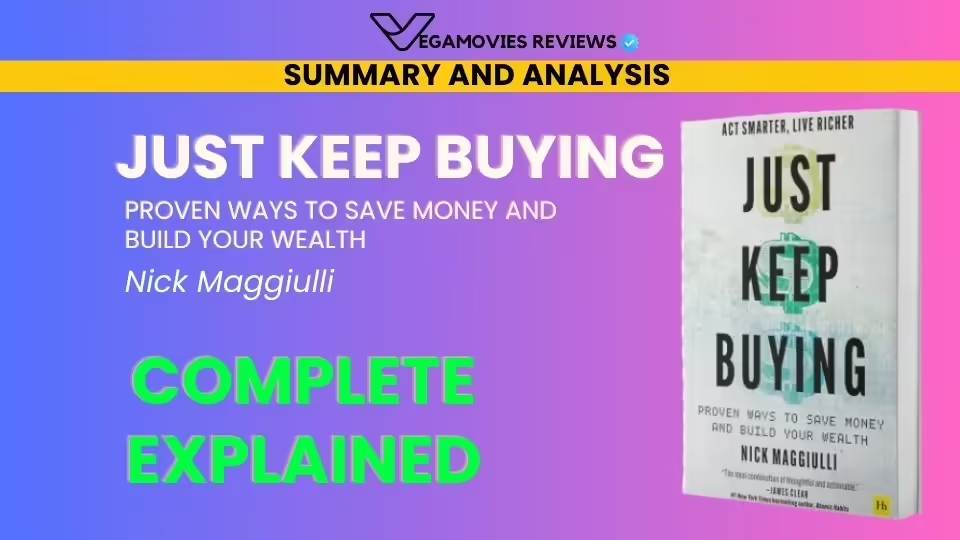Table of Contents
About Book
You can be rich. You can enjoy a comfortable retirement and secure a better future for your family. Its secret is to start investing from now itself. In this summary, you will learn about such important lessons that will help you grow your money. You will learn why you should invest, where to invest, how to handle the unpredictability of the stock market, what to do during a market crash and much more. We hope that this summary will encourage you to become an investor. With these guidelines you will be able to achieve long term success.
Who should read this summary?
* To Employees
* People who want to invest their money
* To new investors
About The Author
Nick Maggiuli is a Data Scientist and COO of Ritholtz Wealth Management. They manage the operation of the company and give input of their intelligence in the business. Nick has a blog called Dollars and Data where he talks about the link between personal finance and data. His work has been published in The Wall Street Journal, The Los Angeles Times and many other publications.
JUST KEEP BUYING: Proven ways to save money and build your wealth By Nick Maggiulli Full Book Summary 2023
Introduction
Just keep buying means investing regularly in a diversified portfolio for the long term. Buy more stocks, bonds, real estate etc. whether its valuation is high or low, whether the bull market is running or bear. Make investing a habit, just like paying rent or buying groceries.
Just keep buying with an aggressive approach which will give you a chance to grow your money easily. As you will know further in this summary, the investors of today’s time have many advantages. As such, free trading is available on major investment platforms. You can also invest in index funds through which you can have your own shares in top performing companies.
That’s why you should not be afraid. In this summary, you will learn more concepts that will convince you that you just have to keep buying. Read More : The Audacity of Hope Thoughts on Reclaiming the American Dream By Barack Obama Full Book Summary 2023
Why Should You Invest?
There are three reasons why you should invest: to save for your future, to protect your money from inflation and to shift your human capital to financial capital.
First of all, let’s discuss about saving for your future. A day will definitely come when you will not be able to work or will not want to work. If you invest now, even after you retire or become old, you will still have some source of income.
It can be difficult to imagine yourself as an old man of 60, 70 or 80 years. You might feel that you are young and strong right now and will always remain so. But research shows that imagining your future can be a great motivation for you.
In one experiment, some participants were shown their digitally aged photos. Researchers found that those who saw their photos invested 2% more in their retirement funds than those who did not see their photos. That is, it is possible that seeing a realistic image of yourself in the future will encourage you to invest more in the long term.
In another study, participants were asked the reason for their savings. Researchers found that people who cited retirement and emergencies as reasons for saving saved more regularly than those who had other financial reasons, such as saving for a home or vacation.
If it is selfish to save or invest for your old age, then there is nothing wrong in it.
So next, we will talk about how to protect your money from inflation. Inflation is like an invisible tax which you keep paying for years and years without noticing it. The cost of groceries, children’s education, transportation, property maintenance, etc. keep on increasing every year while your salary probably remains the same.
It may be that the effect of inflation may not be known much in a year or two, but you will see its big impact in the coming time. For example, if the annual inflation rate is 2%, the purchasing power of your money will be halved in 35 years. If the inflation rate is 5%, your purchasing power will be halved in 14 years. Therefore, the higher the inflation, the more money will lose its value.
Investing is an effective solution to this problem. You can fight inflation by buying assets, the purchasing power of assets increases with time. For example, you invest $1 in 1926 long term US Treasury bonds. By the end of 2020, it will increase to $200. Now suppose you invest $1 in a basket of US stocks as well and it will grow to $10,937 in the same time period.
Think what will happen when you have already retired. You might not be getting salary, but the prices of things of your basic needs would be increasing in the same way. By investing you will have a secure, passive source of income.
In the last, let’s talk about shifting human capital to financial capital. Human capital means the value of your knowledge, time or skills. You can increase your knowledge and skills with age but time is such a thing that will decrease with time. With increasing age, your body will also become so weak that you will not be able to do all that which you are able to do today.
For example, you earn $50,000 annually for the next 40 years, save 15%, and get a 6% annual return. In this way, you will have money to buy the things you need and you will earn more money from compounding interest. That means even after you retire, your money will continue to earn for you.
If you start investing from today itself, then you will be able to sit comfortably after retirement. You will not have to worry about your medical bills, children’s future or other expenses. When you are enjoying with your loved ones, your investment will be growing even at that time.
What Should You Invest In?
Now comes the next important question. Where should you invest? You might have seen videos of “Investment Gurus” or might have read books which tell the right way to reach Wealth. But all this is a lie. There are many ways to get rich and win. You should study different methods and find out which one will be best for you. That is, you have to create a diversified portfolio of income producing assets like the title of this book, ‘Just Keep Buying’ means just keep buying.
So what type of investment should you buy? In this chapter, we will talk about some asset classes which you can use to become rich. We will discuss the advantages and disadvantages of each one by one and also tell how you can invest in them. Before taking any decision, understand each and every class carefully.
Stocks, also known as equities, represent the ownership of a company. It is a good investment as it is a reliable source of wealth generation in the long term. A team of researchers studied the equity returns of 16 countries from 1900 to 2006. He found that all of them had given positive returns in the long term. Sweden earned 8% annual return in those 206 years. The US earned 6.8% real return on average while Belgium’s return, 2.7%, was the lowest.
It is important to note that between 1900 and 2006, there had been two World Wars and the Great Depression, even then the equity of these 16 countries had generated positive returns in the long term.
Another advantage of stocks is that they do not require maintenance. Once you buy, someone else can manage them while you keep getting the returns.
Yes there is a drawback. Stocks can fall in price twice every 100 years by 50%, every 4 years by 30% and every other year by 10%. Stocks always fluctuate. Stocks are volatile or unpredictable. Keeping them can be emotionally challenging. But there is only one thing to keep in mind that you should focus on investing long term in it. As history shows that finally stock prices definitely go up after any crisis. That’s why time will prove to be your best friend.
So how do you buy stocks? You can check with your bank or find a trusted online stockbroker. You can take individual stocks, or you can take Exchange Traded Fund (ETF) or any index fund. The authors of this book recommend Index Funds because with this you can invest in many companies very easily and cheaply.
For example, by investing in S&P 500 Index Fund, you can get stocks in top US companies. Whereas Total World Index Fund gives you an opportunity to explore the best performing stocks globally. As a stockholder, you can earn dividends or a share of the profits of these businesses.
After this, let’s discuss about bonds. Buying a bond means that you have given your money to the government or a company for a fixed period. Bonds require the borrower to pay coupons or pay regular interest to the investor until the principal amount is repaid in full by the maturity date of the bond.
What is received from the bond is obtained by dividing the annual coupon payment by the price of the bond. For example, suppose you take a $1000 bond and earn $100 as coupon payment, then the yield of the bond is 10%. Usually, when books talk about bonds, they mean US Treasury bonds, but other countries also have their own bonds.
Apart from US treasury bonds, there are also municipal bonds (lending to local government), corporate bonds (lending to companies) and foreign government bonds. They pay more interest than other types of US treasury bonds and are also more risky. This is because the US government can simply print a few more dollars to pay investors, while local or foreign governments and corporations can fail to make their payments.
Because their returns are less than stocks, bonds act like a diversifying asset. They are not risk assets. Despite the low returns, bonds provide safety because they are not affected by the ups and downs of the stock market.
There is one more reason why you must add bonds to your portfolio. bonds will always go up even if stocks or other risky assets are going down. Bonds give more consistent returns than other assets. You can also use bonds to rebalance your portfolio and generate extra cash. For example, suppose the stock market crashed and you lost your job, but if you have bonds, you can earn money by selling them. But if all your money is invested in stocks and other risky assets, then you can be in big trouble.
Something similar happened during the Kovid-19 pandemic. Imagine three portfolios in one graph. One is S&P 500 index, another is 80% stocks and 20% bonds and the last one is 60% stocks and 40% bonds. When the stock market bottomed in March 2020, the S&P 500 suffered the most, with only the 60/40 portfolio being the least affected.
So, despite the low returns, you can rely on bonds at the time of any crisis. You can directly buy individual bonds. But the author says that you should buy them through ETF or bond index funds as it is easier. Apart from this, you can also check the website of your bank or any trusted stockbroker.
Let us now move towards the next asset class, which is real estate property. Investing in property would be a very good decision as you can give it on rent to others. Your tenants will help you repay the loan on the property while you can enjoy its long term price appreciation.
If you borrow to buy a property, then this can be your leverage. For example, if you have $100,000 to buy a $500,000 property, you can borrow the remaining $400,000. Now if the value of your property increases to $600,000 by next year, you can sell it to pay off your loan and still be left with $200,000 with your original money plus some price increase.
However, leverage can also have a negative effect. If the price of the property drops to $400,000 and you sell it, your $100,000 investment will be gone. But such big price crashes are very rare. Generally you can take advantage of leverage as a real estate investor.
Now let’s discuss what are its shortcomings. Being a landlord you have to deal with your tenants, maintain the property, list your property on airbnb or rental sites.
You can get higher returns than stocks or bonds but investing in property requires more work. This asset is also not diversified. You will be taking all the risk on that property. If there are many problems or expenses or a crisis like Kovid-19 pandemic, then you can suffer a lot.
Despite all this, if you want to have more control or something solid on your investment, then you can invest in real estate and become a property owner. Now because these pros are full of technicalities and paperwork, you can buy directly from the seller or any real estate agent. But before taking the property, you should do complete research and take the decision after thinking carefully.
The last income producing asset we will discuss is REIT or Real Estate Investment Trust. Basically, in REIT you own the real estate but you don’t manage it yourself. A business has these properties which manages them and as an investor, it pays dividends to you. Actually according to law REIT should pay 90% of its income as dividend.
There are some residential REITs that own apartment buildings, single family homes, manufactured homes and student housing. There are also some commercial REITs that look into office buildings, retail space, warehouses and other commercial properties.
REITs are also offered as publicly traded, private or publicly non-traded. Private REIT is offered only to a few accredited investors whose net worth is $1 million or more. Publicly non-traded REITs are not available on the stock exchange but can be found by public investors through crowdsourcing websites.
On the other hand, publicly traded REITs are available to all investors on the stock exchange. Therefore it would be better to invest in REIT index funds instead of individual publicly traded REITs.
During good times, REIT stocks can outperform. But during market crash they go down along with the stocks. Means REIT is more risky asset than diversification asset.
Let us do a comparison of income producing assets. Usually the annual compounded return of stocks ranges from 8% to 10%. Bonds range from 2% to 4%, properties range from 12% to 15% and REITs range from 10% to 12%.
The rest of the investments are small business, franchise or angel investing with 20% to 25% annual compounded returns and many opportunities for growth. Farmland is a good solution against inflation with 7% to 9% annual compounded return. Royalty is usually stable and gives a return of 5%-20%. Cryptocurrencies, gold and artworks are not reliable income streams, so it depends on the investor’s perspective.
Why You Shouldn’t Buy Individual Stocks
There are two reasons to convince you why you should not buy individual stocks. The first is the financial argument. Accordingly, even the world’s best professional investors cannot beat the performance of an index like the S&P 500, so there is no question of you getting a chance.
You can search the report of every equity market in the world and see that 75% of the stocks do not beat their benchmark for more than 5 years and behind this 75% is the support of best money managers and full time working analysts. Despite this, they are not able to outperform this benchmark.
Apart from this, research shows that only a small percentage of individual stocks perform well in the long term. A paper titled “Do Stocks Outperform Treasury Bills” showed that between 1926 and 2016, only the top 4% of stocks outperformed US Treasury Bills, and how can you be sure you are in these? Would you rather choose from the 4% winning stocks and not the 96%?
Apart from this, after 100 years in March 1920, all 20 companies in the Dow Jones Industrial Average disappeared from the index. Which means it is certain that even the biggest and most successful companies will not always win.
So you can see what can be a problem in choosing the stock. Beating an index is so difficult that it is beyond the reach of even the most skilled investors. The percentage of winning stocks is very less and they are also not always on top.
That is, if you have an index fund or ETF, then it will be better than buying individual stocks. Due to this, there will not be much stress on you and your chances of losing a huge amount will also reduce.
Let us now proceed with the existential argument. It questions your skills as an investor. How do you know you are an expert at picking individual stocks? By investing in an individual stock in a day, a week, a year, will you come to know that you are a good stock picker?
It may take many years, even then you will not be able to say with full confidence. You have to buy those stocks now and wait for long time for the result. You can then compare those results with an index fund such as the S&P 500.
There are many other factors to pay attention to in this. Even if you outperform the index, is it because of your skills or because of changes that are beyond your control? What if the price of an individual stock goes up because many people invested in it? Then it is not because you have analyzed it well, but because of luck.
Let us assume that you are a professional investor of a well-known mutual fund. According to a study even professionals like you underperform the benchmark every three years or less. You might be asking yourself whether it was just a bad day in your life or have you lost your magic touch forever. This is the existential argument.
Studying individual stocks and comparing their annualized returns can be a tiring and stressful task. If the prices of individual stocks go down, then within a few hours your huge amount can be lost.
Yes, stock pickers help us by analyzing companies and influencing the market. But by investing in index funds and ETFs, we can easily save our money and peace of mind.
How Soon Should You Invest?
Let us make you a little happy too. Do you know that most of the time the stock market is up. During the 20th century, the Dow Jones Industrial Average rose from 66 to 11,497 and that too after two world wars, the Great Depression and a dozen recessions, oil shocks, a flu epidemic and President Richard Nixon’s presidency. Incidents like regression happened.
This does not apply only to the US stock market. As mentioned earlier, the global equity market experienced a long term positive trend during this time. Now when you have this guarantee, then you should invest as soon as possible. Every single day that you hesitate, you miss an opportunity to grow your money. So now just jump into the fray and invest.
Suppose you have got $1 million from somewhere and you want to keep increasing this money for the next 100 years. However, you can only choose between these two investment strategies. You can invest the entire $1 million today or decide to invest 1% of it every year for the next 100 years. So which of these strategies would you choose?
Better will be that you invest it completely today itself. If you do this, your $1 million will grow over time. But if you invest $10,000 every year, the stock price will increase but the value of your remaining cash will decrease due to inflation.
Investing $1 million at once is risky but you can reduce this risk by investing 60% of your money in stocks and 40% in bond portfolio. This way, you can do better than $10,000 invested every year in 100% stocks and reduce risk.
Even if you do not have $ 1 million, remember that the stock market is mostly up, so if you can invest somewhere now, your money will keep growing. You will be saved from inflation and will also be prepared for your retirement.
Why You Shouldn’t Fear Volatility
Here is another investing advice for you. The biggest risk is not taking any risk. If you are afraid of falling stock price and refrain from investing, then you will lose the opportunity to grow your money. To achieve success in long term investing, you have to accept the volatility, the unpredictability of the market and the occasional ups and downs.
Now suppose there is a magical genie who can give US stock market information at the end of every year. This genie cannot tell you which individual stocks you should invest in or how the market will perform but he can definitely tell you the lowest point the stock market can fall in the next year. This percentage of drop is called maximum intrayear drawdown.
So the question is: By what percentage drop would you want to move from stocks to bonds? What if the genie told you that the market could fall by up to 40% at any point in the next year? Will you keep investing or not? What if it drops to 20%? What is your limit?
Before you answer, here is some information which will help you in this. The average maximum intrayear drawdown of the S&P 500 since 1950 has been 13.7%. The worst decline was in November 2008 when the index dropped 48%.
Let’s start with the first scenario. Suppose you are conservative and you tell Genie that you would not like to invest in stocks in those years when the drawdown was 5% or more. This is called Avoid Drawdown Strategy because you invest all your money in bonds in these 5% or more drawdown years.
If you follow the same strategy from 1950 to 2020 then you will miss many opportunities. By 2018, you will have 90% less money than if you had applied a buy and hold strategy where you would have invested in stocks full time, regardless of the drawdown.
By following the avoid drawdown strategy, you will mostly stay out of the stock market. That is because from 1950 to 2020 there has been less than 5% drawdown in only 7 years. Means you did not take any risk at all and you also missed the growth of the stock market.
Now let’s talk about the next scenario. Suppose you avoided only those years when the drawdown was more than 40%. So the only year you were out of the market was 2008. In this scenario, the avoid drawdown will outperform the buy and hold strategy, but only marginally.
That is, here the first scenario is very safe and the above one is very risky. That’s why the best size to avoid drawdown is 15% or more. This means that when the market drops by 15% or more, you invest in bonds. Then in the rest of the years you invest in stocks. In this way you will be able to maximize your long term wealth.
In the last scenario, you will be out of the stock market only for one third time. If you adjust your tolerance level to 20% or 30% then you will lose money because you spent more time in stocks when they were going down.
But unfortunately there is no magic genie who can tell you about next year’s drawdown. It is impossible to know when the stock market will drop by 5%, 15% or 40%. So now the only solution remains is to diversify our portfolio. By investing in many different types of assets, we can protect ourselves from the unpredictability of the stock market.
The most important thing is that you have to accept that volatility or unpredictability is an essential part of being an investor. If you can’t keep calm when the market drops 50% double or triple fold in a century, then you shouldn’t even think of becoming an investor, nor can you ever win the big game.
How to Buy During a Crisis
The Kovid-19 pandemic shook the whole world. On March 23, 2020, the S&P index went down 33% from its last month’s high. If you were an investor during that time, would you have sold your stocks or would you have kept your spirits up amidst the lockdown and business closures and uncertainty?
Baron Rothschild, the 18th century banker once said “The best time to invest is when there is blood in the streets”. He increased his wealth even when other investors were panicking during the Battle of Waterloo. This means that you can still buy stocks when the price is low and as the stock market recovers after the crash, your stocks will also keep on increasing gradually.
For example, suppose you invest $100 every month in the US stock market from September 1929 to November 1936. This time frame covers the 1929 crash and the subsequent recovery of the stock market.
This graph shows that every $100 you invest would have grown by November 1936. The biggest gain would be on the $100 you invested during the lowest point, which was the summer of 1932. Every $100 you bought then would have grown to $440 by November 1936.
It shows 3 times more growth. But most market crashes give investors an increase of 50% to 100% in their wealth. Such huge recovery is due to a basic mathematical fact. To equalize every percent loss, there is a need to earn a bigger percent gain in return.
To recover 10% loss, 11.11% gain would be required. 25% gain is required to recover 20% loss. 100% gain is required to recover 50% loss. If you plot this on a graph, this exponential relationship creates an upward trend, showing the gains we need to fully recover from losses.
On March 23, 2020, the S&P 500 had a loss of 33%. According to the graph, it needed 50% gain to come back to the previous position. Actually it happened only after 6 months. Investors who had bought stocks on that day, after 6 months their money had increased by 50%.
Let us take one more proof to convince you why you should buy stocks during crisis. For example, whenever the market fell by 30% or more between 1920 and 2020, you invested in stocks. A graph showing your annualized returns during those 30% or more drawdown months. In such a situation, there is less than 10% chance that you can get 0% to 5% annualized return. Half the time you will get 10% or more annualized returns.
Your returns will be even better if the market drops by 50%. More than half the time, you will have annualized returns of 25% or more. Means you have no need to be afraid. You should keep investing even during the crisis because most of the stock market recovers completely from the crash within a few years or even in 10 years.
If you still have doubt then there is some more proof. A study done on 39 countries from 1814 to 2019 shows that the probability of decline in stock market returns against inflation is 12%. This means that within 30 years, there is only a 1 in 8 chance that inflation could cost investors.
And the biggest thing is that if you keep investing from time to time, then the chance of loss is very less as compared to investing only once. For example, in December 1989 the Japanese stock market was at its peak and after 30 years in 2020 there is no benefit from the loss. But even if you had invested $1 daily from 1980 to 2020, you would have got a small positive return.
That is, if you are afraid to invest during the crash, you will be left behind. After all, after some time the stock price may increase by 25%, 50% or maybe 100%. So will you still be poor or would you like to become super rich?
When Should You Sell?
This book advises you to keep buying, but there will come a time when you will need to sell. This is the most difficult decision in investing. Your emotions will tell you not to sell now because you can get higher returns in future or you can incur losses by selling now.
To avoid this confusion, you have to keep some things in mind. Sell only to rebalance your portfolio, to exit a losing position or to meet your financial needs, rather than selling on emotions. Apart from these three situations, avoid selling to avoid tax.
Before discussing these conditions, you must understand that instead of selling in haste, sell at the right time. As we mentioned earlier, most of the markets remain up most of the time. When you sell after many years, you will still have some money left which will be growing slowly in the market. But if you sell immediately, you will not get the benefit of rising price. That is, overall you should buy stocks now and keep selling them gradually to maximize your long term wealth.
Now let’s start with the first condition of selling. Why should you balance your portfolio? When you start investing, you have a target allocation. For example, 60% investment in US stocks and 40% in US bonds. If you have $1000, that would be $600 in stocks and $400 in bonds.
If you do not rebalance it, then your portfolio will start dominating its higher returning asset. For example, let’s say you made a single investment of $1000 in 1930 and never rebalanced it in 30 years. By 1960, 75% to 95% of your 60/40 portfolio would be stocks.
Whereas if you rebalance it annually, your portfolio will still have 60% stocks till the end of the period. That is because US stocks give better returns than US bonds after a long time. In this way, by rebalancing every year, you invest your returns from stocks to bonds and maintain a 60/40 allocation.
The ‘Never Rebalance Strategy’ outperforms the ‘Rebalance Annual Strategy’ due to higher returns on increasing stocks ratios. But smart investors still rebalance to reduce risk. This is the purpose of rebalancing. If you never rebalance your portfolio, then you will not have control over the risk. Your 60/40 portfolio will become 75/25 or 95% stocks or 5% bonds in a few years. You know that the stock market is unpredictable and you may have to bear a lot of loss.
Annual rebalancing is good because you will not have to monitor your portfolio again and again. You have to do this only once in a year and you can enjoy the rest of the time comfortably. Rebalancing every time your stock allocation goes up 70% or down 50% can be a hassle.
You can rebalance annually during tax season as well. In this way, you can pay capital gains tax from your portfolio along with other tax related responsibilities. This will save both your time and effort. If you keep rebalancing in between, then you will have to pay tax and your wealth will decrease instead of increasing.
But there is another way to rebalance your portfolio without paying tax. For this the author says that you should just keep buying. For example, if your portfolio becomes 70/30, instead of selling 10% of your stocks, you can buy 10% more bonds, thus making the ratio 60/40 again. In this way, you will not have to pay capital gains tax and at the same time, investing more annually will minimize your chances of loss during a market crash.
But this method is effective only for those investors who are still in their accumulation stage. If your portfolio has grown a lot over time, it may be difficult for you to buy more. That’s why you can rebalance by selling it. But avoid repeated selling to save tax.
Now let us discuss what is the next condition to sell: that is to exit the concentrated position. Concentrated position means investing in an individual security. For example, you work in a company that offers equity compensation. In such a situation, one day you will come to know that a major part of your wealth is in that one security.
It is good to make profit from this, but it would be better if after some time you sell a part of that security. The amount you sell depends on your goals.
For example, you have mortgage debt and a concentrated position from your company’s equity compensation. You can sell that security to pay off your mortgage. This will give you lower returns as the value of that individual security will probably increase faster than the value of your house. But your risk will be less because that future return is just a possibility. But you have to repay your mortgage.
You can sell 10% of the security every month or you can sell 50% and keep the rest. It’s up to you. But whatever you do, don’t sell everything at once. Tax has its own consequences and there is also a possibility that the prices of those stocks may go up in future. But remember that individual stock indexes will always underperform against an index like the S&P 500. You have to decide what level of risk you want to take and then sell accordingly.
Now let’s move towards the final reason for selling. That is to enjoy your life. You can spend all your money on a comfortable retirement, or on a summer vacation, or on your children’s college education, family life and health insurance, or whatever.
The authors are saying to do so because of diminishing marginal utility. This means that the more you have of something, the less you value it.
For example, you would be happier growing your wealth from $0 to $1 million than growing it from $1 million to $2 million. You will feel very happy by fulfilling the needs of your family, but if you have more money then whatever luxuries you can afford, it will not give you much happiness.
So selling is not bad. Play games and put your wealth on the line and then spend your money on memorable experiences with your family. After all, the purpose of investing is also that we can live such a life which we always wanted to live.
Conclusion
First of all you understand that you have to invest to save for retirement, to beat inflation and to shift human capital to financial capital.
Second, you learned about stocks, bonds, real estate property and REITS. Each asset class has its own advantages and disadvantages. Your portfolio should be diversified to manage the risk and grow your wealth.
Third, you learned that you should not buy individual stocks as they can never outperform the index. Leave this hassle and invest only in index funds or ETFs.
Fourth, you know that invest as much as you can invest now. If you do not invest now, you will miss the growth of the stock market. So better would be to buy stocks now to increase your wealth and avoid the effects of inflation.
Fifth, you learned not to be afraid of the unpredictability of the stock market. By staying out of the market for a long time, you will miss many opportunities. For this make a divers portfolio and focus on long term.
Sixth, you learned how you should keep buying stocks even in crisis. Remember, most stock markets recover from crashes within a few years or even 10 years. For every percentage loss, even more percentage gain is needed to make it equal. Hence buying during crisis can make you rich quick.
In the last, you know when the stocks should be sold. Instead of taking decision by coming in emotions, you have to follow some conditions. Sell only to rebalance your portfolio, exit concentrated positions or buy essential items.
We take financial decisions every day without knowing what will happen in future. We have neither a magic lamp nor a time machine, but in this summary, you learned about those guidelines which will help you to increase your money in the long term. You can become rich, you just need to start investing as soon as possible.
Finally, if you have reached the end of this summary, then Congratulations, there are very few people who invest time on knowledge, otherwise you could have wasted time elsewhere. See you soon with a new summary
Jai Hind
Read More
Dream Girl 2 box office collection day 6: Raksha Bandhan brings in nearly 60 crore for Ayushmann Khurrana’s film
SUKHDEV By VGRL Full Book Summary 2023
The Audacity of Hope Thoughts on Reclaiming the American Dream By Barack Obama Full Book Summary 2023
Gadar 2 box office collection day 20: The Sunny Deol-Ameesha Patel film grosses Rs. 8.8 crore on Raksha Bandhan
Jailer 2023 Movie Full Explained | Jailer Movie Ending | Jailer MOVIE STORY













